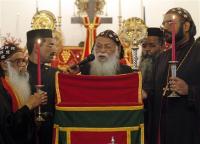BROOKLYN–There’s a change of discourse. The prayers cease at St. Mary’s Orthodox Church in Brooklyn and the hand greetings begin. The short, intense eye contact suggests that mass is not the only reason for coming to church. Then the blessing is passed on to the next member of the community.
It’s the ‘Kiss of Peace,’ part of the Orthodox mass in which the priest encourages all members of the community to wish each other peace by giving “the holy and divine embrace” before Communion. The mass is read in Malayalam, one of the 23 official languages of India. But for this particular part of the mass, the priest reads in English.
“Let us in love of our Lord and our God give peace to one another, everyone to his neighbor by the holy and divine embrace.” Even though the priest speaks into a microphone his voice is so soft that it is hardly audible. Still, his congregation knows what to answer: "Lord God make us worthy of his peace all the days of our lives.” The words are spoken in Malayalam.
“The priest, Father John, represents Jesus and he gives love to the altar boy by rubbing his hands,” explains Anu Joseph, 25, who teaches at the Orthodox Indian Sunday school after mass. “The boy passes it on by touching the next person's hand. Normally, the men and women don’t sit together, but our church is so small that they might offer the peace blessing to each other anyway.”
Most of the mass is read as call and response between the priest and his congregation. The priest reads a line or two and the congregants answer in verses from a liturgical book.
But the heart of the peace ritual is not necessarily verbal; it is what happens between the worshipers. The stroke of hands and the brief eye contact between parishioners wishing each other peace shows that the church is built on its people and their interaction.
Nancy Crackel, 21, slides her hands between mine. She wears a turquoise sari with golden stitching; little glass pearls are woven into the fabric. She tries to cover her thick, shiny hair with a matching veil, but it keeps sliding down to her shoulders. Six or seven gold bracelets on her left wrist make a rattling sound as she adjusts her veil. She has kicked off her sandals. The nail polish on her feet and hands matches her baby-pink lipstick. “Make sure you don’t leave before you’ve had some food,” she whispers.
The congregation of Brooklyn St. Mary’s consists of 13 families. They rent the church room from a Korean Church in Brooklyn. It’s located on 2870 86th St., not far from Coney Island. After the three-hour mass everyone goes to the basement. They eat rice, fish, beef and vegetable curry and chat together. Married men stay in one group, married women in another. Young people laugh in a corner. Small children run between the groups. About an hour later they all leave, peacefully aware of having done their religious duty, caught up on life in the community and happily full.
This Glimpse of Faith was filed by News21 Fellow Anna-Katarina Gravgaard


 Print
Print Bookmark
Bookmark
